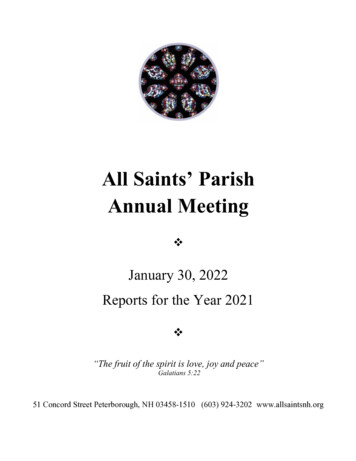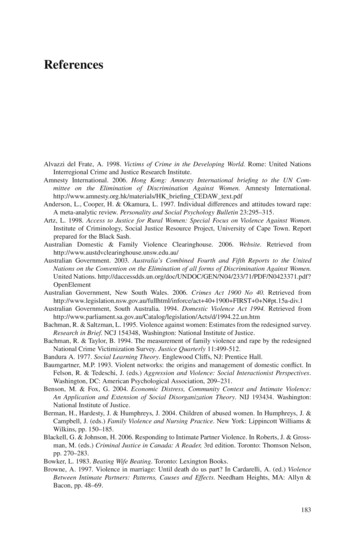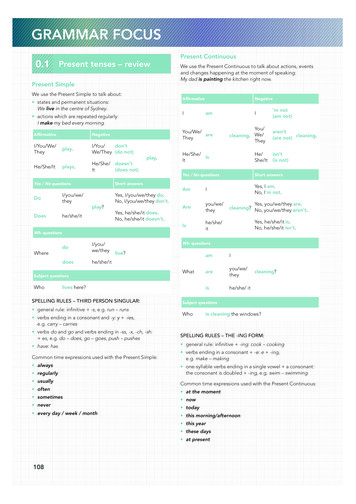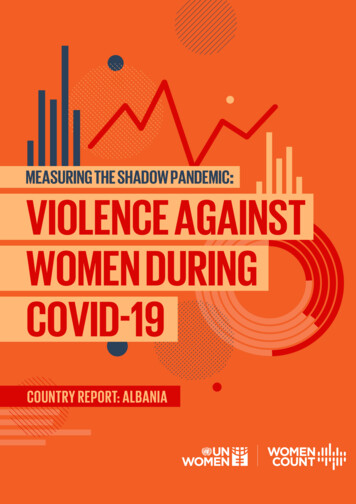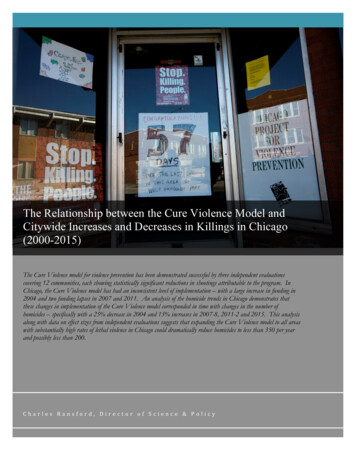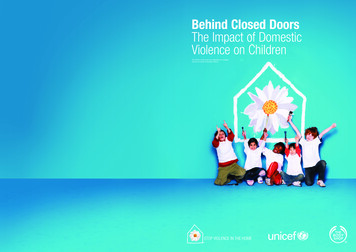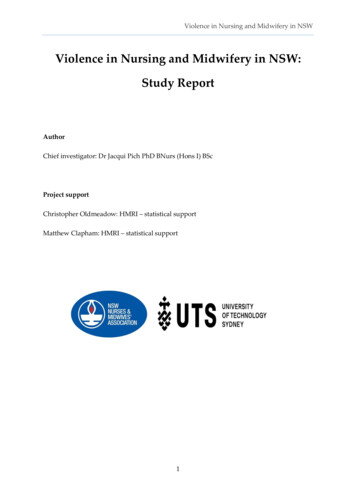
Transcription
11EndingViolenceAgainstWomenplaintalk
it’s our time.Aboriginal women and girls are strong and beautiful.They are our mothers, our daughters,our sisters, aunties, and grandmothers.Sisters In Spirit 2010 Research FindingsForsaken: The Report of the Missing Women was released in late 2012. The report was theproduct of the Commission of Inquiry into the missing and murdered women from the DowntownEastside of the City of Vancouver between 1997 and 2002. The scope of the commission’sinquiry was limited to the investigations by police forces and to making recommendations forchanges in the conduct and coordination of homicide investigations. However, the Reportdeals extensively, and very powerfully, with the women—who they were, how they lived, howthey died, how, for years the police bungled the investigations, and how the general publicmostly didn’t care.These are the first few paragraphs of Forsaken: The Report of the Missing Women.Most of us will never have to worry about where we will get our next meal, whatwe will do to get the money we need to live or where we will sleep. We don’tunderstand what it feels like to be consumed by fears about our physical safetyand yet be too afraid to contact the police. On your own, easily forsaken.Forsaken. That is the story of the missing and murdered women.The missing and murdered women were forsaken by society at large and thenagain by the police. The pattern of predatory violence was clear and shouldhave been met with a swift and severe response by accountable and professionalinstitutions, but it was not. To paraphrase Maggie de Vries, sister of murder victimSarah de Vries, there should have been mayhem, searches, media interest andrewards; but these responses only trickled in over the course of many years.Forsaken: The Report of the Missing WomenCommission of Inquiry, 2012.As articulated by one observer:What is it about numbers?What do they tell us?Do they help us understand?128Ending Violence Against Women
plain talk 11One woman goes missing,then another,then another.For a long time only those who know and love them pay attention.Until the numbers start to add up Finding DawnSisters In Spirit 2010 Research FindingsConsider the following: There are a staggering 600 cases of missing and murdered First Nations women acrossCanada dating back to the 1960s. Most of these cases remain unsolved. A disproportionatenumber of the missing and murdered women are First Nations. In British Columbia forexample, only 3% of the population is Indigenous women, yet they comprise approximately33% of the missing and murdered women. So many Indigenous women and girls wereassaulted, disappeared or murdered in communities on or near Highway 16, the 720kilometre stretch of highway between Prince Rupert and Prince George in the northerninterior of British Columbia, that the stretch of highway has become known as the Highwayof Tears. Indigenous women experience higher levels of violence, both in terms of incidence andseverity than any other group. Indigenous women in Canada are five times more likely to die of violent circumstances thanany other group. Overall, 21% of Indigenous women reported being victims of spousal violence in 2004,almost four times higher than for non-Indigenous women.Royal Commission on Aboriginal PeoplesThe 1996 Report of the Royal Commission on Aboriginal Peoples identified a number of factorslinked to violence in Aboriginal communities including racism and systemic discriminationagainst Aboriginal peoples, economic and social deprivation, alcohol and substance abuse,overcrowded and substandard housing, breakdown of healthy family life resulting fromresidential school upbringing, and the impact of colonialism on traditional values and culture.Standing Committee on the Status of Women Study of Violence Against AboriginalWomenIn 2009, nearly 15 years after the Report of the Royal Commission on Aboriginal Peoples, theStanding Committee on the Status of Women (the Committee) began its study of violenceagainst Aboriginal women. The stated intention was to gather information about the extent ofEnding Violence Against Women129
it’s our time.such violence, programs in place to address it, the root causes, and what steps could be takento break the cycle.In March 2011, the Committee tabled an interim report called Ending Violence AgainstAboriginal Women and Girls: Empowerment, A New Beginning. The Report captured what theCommittee heard from more than 150 witnesses in hearings in Ottawa and in 14 communitiesacross Canada.The Committee reported that: in 2009, Indigenous women were almost three times as likely as non- Indigenous womento self-report being the victim of a violent crime. The majority of violent incidents againstIndigenous women were perpetrated by males who were acting alone. In addition, mostviolent incidents did not include the use of weapons or result in injury. The exception to thiswas incidents of spousal violence, where about half of Indigenous female victims reportedbeing injured. In 2009, most violent incidents against Indigenous women were not brought to the attentionof police or any other formal victim service. Across Canada, the disproportionately high number of missing and murdered Aboriginalwomen is a distinct phenomenon that highlights Indigenous women’s vulnerability. TheStanding Committee on the Status of Women heard testimony about police and policyresponses to these cases and about the impact on both families and communities whofaced the loss of these women.For its final report, the Committee chose to shift its focus from the aftermath of the violenceto empowering young Indigenous girls and women, supporting their desire to strive for abetter life of independence, confidence, influence and power, with the goal of reducing thevictimization, poverty, prostitution and abuse experienced by Indigenous women and girls.So far, we are seeing responses that only react and onlyput resources in the hands of authority.We must do better.We must support family and work together to build stronger solutions.We must start from the infants and work our way up.We need to raise healthy children so we can have strong, educated womenand we can be providers to our families,and so we’re not stuck in the cycle of poverty again.130Ending Violence Against Women
plain talk 11In study after study, year after year, the same factors are identified as being significantcontributors to violence against women. PovertyInadequate HousingFood InsecurityLack of Health ServicesInvolvement in the Sex TradeRacismSexist AttitudesSubstance AbuseLack of EducationLack of OpportunityLack of SupportDenial of Language, Culture and TraditionNeed for a National Public InquiryIn December, 2012, the Assembly of First Nations called once again for a national public inquiry.In a document entitled: Demanding Justice and Fulfilling Rights: A Strategy to End ViolenceAgainst Indigenous Women and Girls, the AFN states:There is an immediate and pressing need to seek justice for Indigenous women and girlsin Canada and ensure that they have the same opportunities to see the fulfillment of theirrights, regardless of where they reside. The Assembly of First Nations (AFN) is well aware of theunacceptable levels of violence against Indigenous women and girls and is committed toaction. It is essential that any strategy developed must include justice for women and girls whoare or have been victims of violence, changes to laws and policies that allow these problems topersist, the assurance of adequate support services and a fundamental societal shift that will nolonger allow epidemic levels of violence against Indigenous women and girls to continue.Previous, Current and Ongoing EffortsNumerous justice inquiries, task forces, studies and federal/provincial/ territorial workinggroups have generated hundreds of recommendations for governments, service providers,communities, law enforcement and the judiciary to prevent violence and better addressviolence once it occurs. However, chronic and systemic issues have hindered the prioritizationand implementation of these recommendations.Ending Violence Against Women131
it’s our time.Broad priority areas of recommendation from these initiatives include: Examining the entire spectrum of economic, social, political, cultural, and civil rights thatare available to Indigenous women and girls in Canada and how those rights manifestwithin their daily lives. Better inter-jurisdictional communication and coordination between emergency responseand law enforcement organizations as well as between the federal and provincial/territorialgovernments. Improving police treatment, response and investigation of incidences and reports ofviolence, disappearance, or murder of Indigenous women and girls. Providing appropriate shelters, emergency interventions, and safe housing for women andchildren at risk of or experiencing violence. Clear protections and safeguards for the most vulnerable, including sex trade workers andchildren in the child welfare system. Call for a comprehensive national inquiry or Royal Commission into the systemic andspecific incidences of violence against indigenous women and girls.It is time to move from recommendations to action.In 2010, Canada announced that 10 million would be allocated over two years to addressviolence against Indigenous women in Canada. The majority of these funds were targeted atexisting police services to improve investigations, databases, and victim services, however verylittle was identified for community based interventions to combat violence and better serveIndigenous women and girls in their communities. The history of federal interventions on FirstNation issues has demonstrated that efficient and effective intervention strategies must becommunity based.Perhaps some of the issues are finally coming to the public consciousness. This article appearedin the Toronto Star late in 2012.Missing, murdered Aboriginal women in Canada deserve an inquiryTORONTO STAR – Sunday December 9, 2012It took the gruesome case of pig-farming serial killer Robert Pickton to bring theproblem to the public’s attention: more than 600 Aboriginal women have gonemissing or have been murdered in Canada over the last two decades — a grosslydisproportionate number of crimes, too many of which have gone unprosecuted.Now what will it take to get the federal government to do something about it?If history is any indication, it will take more than the new resolution, passedlast week by the chiefs of the Assembly of First Nations, demanding that the132Ending Violence Against Women
plain talk 11government establish a public inquiry into the disappearances and killings. Afterall, this is the AFN’s third such resolution.While the government has acknowledged that the number of murdered andvanished women is disturbingly high, calls for an inquiry have gone unheeded.Instead, Justice Minister Rob Nicholson has pointed to a 25-million investment inprograms aimed at tracking and reducing the violence.But those investments, whatever their merits, were made in the absence of acoherent national strategy, and have done more to obscure than clarify thepicture. In 2010, Nicholson withdrew funding for Sisters In Spirit, an organization thatmaintained a database of Aboriginal victims, and put it toward a missing personspolice branch without a specific Aboriginal mandate. The logic seems to be that if(the Conservatives) don’t make an effort to understand the extent of the problem,then it isn’t their responsibility to fix it, said NDP Aboriginal critic Jean Crowder.It’s no wonder the government appears reluctant to face the problem in all itscomplexity; doing so is bound to raise politically sticky, seemingly intractablepolicy questions. Pickton managed to evade B.C. police for years, preying mostlyon Aboriginal sex workers whose disappearances either went unreported oruninvestigated. An inquiry into the botched investigation of the killings revealedthat many of Pickton’s victims had been abused while at residential schools andhad subsequently fallen into lives of drugs and prostitution.A public inquiry would unavoidably raise questions about broader socioeconomic problems in First Nations communities and the extent to which those arethe result of an unresolved history of failed government policies. It would also haveto explain why 50 per cent of violent crimes against Aboriginals go unprosecuted,compared to 24 per cent in the general population, likely revealing unpleasanttruths about our justice system in the process.However reluctant the government may be to open up these unsettling questions,it’s long past time we got the answers.ConclusionThe levels of violence against Indigenous women are a national disgrace. There is too muchpoverty, addiction, racism, lack of opportunity and there is still the intergenerational impactof residential schools. We must all work together to address the risk factors, to break the cyclesof poverty and abuse, and we must hold our officials and leadership accountable. We mustalso ensure that students are provided a safe learning environment that is free from racism andEnding Violence Against Women133
it’s our time.discrimination, that supports and encourages the learning of Indigenous history, language andculture; that nurtures pride in identity; and that respects women.To address the issue of violence,one must understand the history and impact of colonizationon Aboriginal peoples in Canada.It is the ongoing narration of violence, systemic racism and discrimination,purposeful denial of culture, language and traditions,and legislation designed to destroy identity that has led to the realitiesfacing Aboriginal peoples.Sisters in Spirit Report, NWAC, 2010Above all, we must focus on the skills, talents and capacities of women. They are not statistics.They are not unresolved case numbers, These women are daughters, granddaughters, wives,mothers, sisters, aunties and neighbours.ReferencesForsaken: The Report of the Missing Women, Missing Women Commission of Inquiry, Wally T.Oppal, Commissioner, British Columbia. 2012, GB.pdfSisters in Spirit, What Their Stories Tell Us: Research findings from the Sisters in Spirit initiative, 2010,Native Women’s Association of Canada: 0NWAC SIS Report EN.pdf.Demanding Justice and Fulfilling Rights: A Strategy to End Violence Against Indigenous Womenand Girls. Draft – for Discussion & Inputafn draft strategy to ensure rights of indigenous women & girls e.pdfStolen Sisters: Discrimination and violence against indigenous women in Canada. AmnestyInternational, 2004, Ottawa, Ontario. Native Women’s Association of Canada: www.nwac.caEnding Violence Against Aboriginal Women and Girls: Empowerment, A New Beginning. Reportof the Standing Committee on the Status of Women n.aspx?DocId 5322860&Language E&Mode 1&Parl 41&Ses 1&File 117#11Living a Life of Integrity VideoThis AFN Youtube video supports the violence against women piece, role models, andresidential schools: http://www.youtube.com/watch?v V9-jc27eLsg134Ending Violence Against Women
Ending Violence Against Women 131 plain talk 11. Broad priority areas of recommendation from these initiatives include: Examining the entire spectrum of economic, social, political, cultural, and civil rights that are available to Indigenous women and girls in Canada and how those rights manifest
